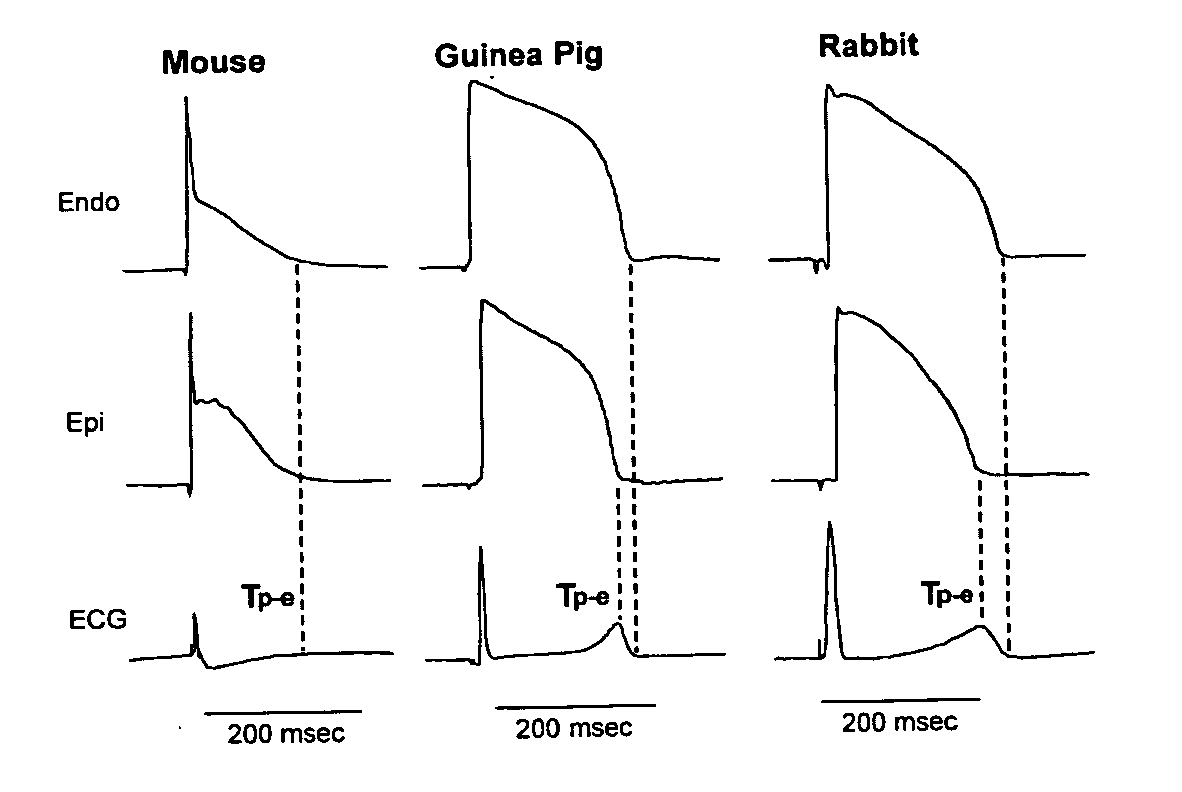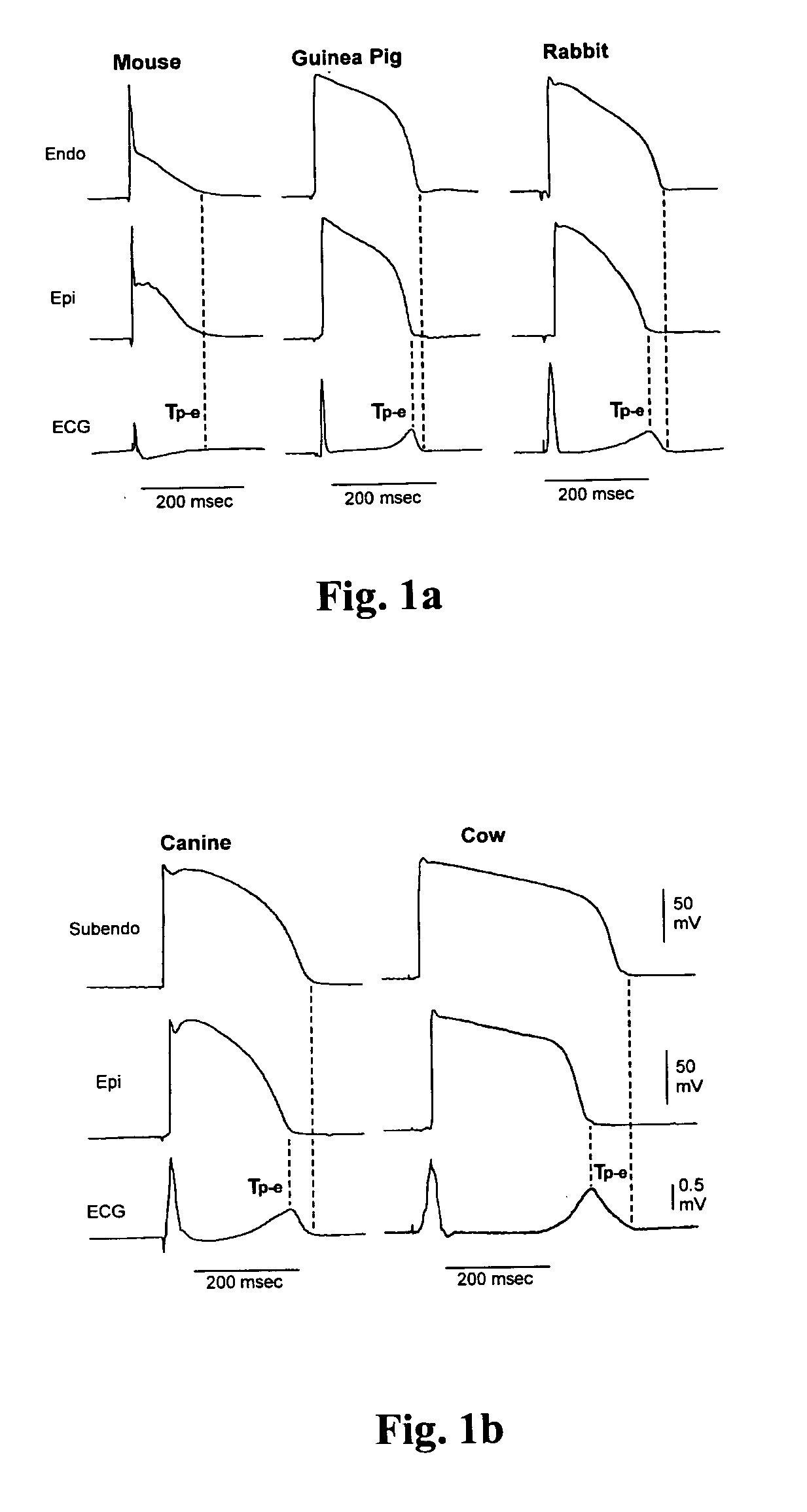Methods for screening compounds for proarrhythmic risk and antiarrhythmic efficacy
a technology of proarrhythmic risk and antiarrhythmic efficacy, applied in the field of safety pharmacology, can solve problems such as qt prolongation, recurrent fainting, and sudden death in humans
- Summary
- Abstract
- Description
- Claims
- Application Information
AI Technical Summary
Benefits of technology
Problems solved by technology
Method used
Image
Examples
example 1
Comparison of Recovery Time Constant (τ) of ICa,L in Representative Mammals
[0057] In preliminary experiments, the time course of L-type calcium current (ICa,L) recovery from inactivation in mice, guinea pigs, rabbits, dogs and cows was examined. As shown in FIG. 2, the recovery kinetics of ICa,L at −40 mV were different among these species, and there was a linear relationship between the time constant (τ) of ICa,L recovery and the corresponding ventricular repolarization time (r2=0.90, pa). The data show that although the left ventricular repolarization time was markedly different among these species (FIG. 1), the ratio of τ of ICa,L recovery to the longest ventricular repolarization time remained fairly consistent among them (FIG. 3b). This indicated that an adequate and constant ratio of the time constant τ of ICa,L recovery to ventricular APD serves as a stabilizer of cardiac cell membrane potential during repolarization phase 2.
[0058] Without intending to be limited to any par...
example 2
Rabbit Left Ventricular Wedge Preparation and Electrophysiological Recordings
Rabbit Ventricular Wedge Preparation:
[0059] Female rabbits weighting 2.5-3 kg were anticoagulated with heparin and anesthetized with pentobarbital (30-35 mg / kg, i.v.). The chest was opened via a left thoracotomy, and the heart was excised and placed in a cardioplegic solution consisting of cold (4° C.) normal Tyrode's solution. Transmural wedges with dimensions of approximately 1.5 cm wide and 2-3 cm long were dissected from the left ventricle. The wedge tissue was cannulated via the circumflex or left main artery and perfused with cardioplegic solution. The preparation was then placed in a small tissue bath and arterially perfused with Tyrode's solution containing 4 mM K+ buffered with 95% O2 and 5% CO2 (T: 35.7±0.1° C., perfusion pressure: 35-45 mmHg). The ventricular wedge was allowed to equilibrate in the tissue bath until electrically stable, approximately one hour. The preparations were stimulated ...
example 3
Screening of Compounds in Ventricular Wedge Preparations
[0061] The following compounds were evaluated for their dose-dependent effect on the QT interval in the ventricular wedge preparations: quinidine, sotalol, bepridil, haloperidol, moxifloxacin, flecainide, citalopram, loratadine, fluxetine and verapamil. Each of these ten compounds was tested in 4 doses ranging from their free therapeutic plasma Cmax to the concentration closely to or greater than 30-fold over the Cmax. After the wedge preparations were perfused with normal Tyrode's solution for one hour in the chamber, control transmembrane action potentials and a transmural ECG were recorded. The preparations were then switched to Tyrode's solution containing a test compound with each dose for 20 minutes.
PUM
| Property | Measurement | Unit |
|---|---|---|
| physiological temperature | aaaaa | aaaaa |
| perfusion pressure | aaaaa | aaaaa |
| time constant | aaaaa | aaaaa |
Abstract
Description
Claims
Application Information
 Login to View More
Login to View More - R&D
- Intellectual Property
- Life Sciences
- Materials
- Tech Scout
- Unparalleled Data Quality
- Higher Quality Content
- 60% Fewer Hallucinations
Browse by: Latest US Patents, China's latest patents, Technical Efficacy Thesaurus, Application Domain, Technology Topic, Popular Technical Reports.
© 2025 PatSnap. All rights reserved.Legal|Privacy policy|Modern Slavery Act Transparency Statement|Sitemap|About US| Contact US: help@patsnap.com



